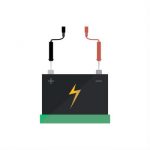Every modern vehicle uses a battery to provide starting current and as an essential current reserve during vehicle operation. A battery has a positive and a negative terminal, and each is connected to the vehicle through heavy electrical cables.
The negative cable is usually simple, connecting from the negative battery terminal to a primary ground point on the chassis. The positive battery cable is usually more complicated. In most cases, it will supply power from the battery to the starter, as well as the power to the primary fuse box.
In some cases, it will have fuses integrated into it at the battery, or involve fusible links as a part of its construction. Sometimes, it is built into the engine wiring harness.
Average Cost of Battery Cable Replacement
Some battery cable replacement cost estimates using common vehicles and $100 an hour labor rate are presented below:
Please take note though that these are all for factory battery cables. There aren’t generally good aftermarket sources for pre-made battery cables. However, a few older vehicles can use universal cables, and sometimes, aftermarket vehicle-specific negative cables can be sourced.
For a 2000 Honda Civic LX with a 1.6-liter engine, the labor time to replace the negative cable is estimated at 0.6 of an hour and a factory part costs about $45. The total cost to complete the job would be about $105 for the negative side.
On the other hand, the labor time to replace the positive cable is estimated at 0.5 of an hour and a factory part costs about $33, which makes the job cost about $83.
For a 2005 Toyota Camry with a 3.0-liter engine, the labor time to replace the negative battery cable is estimated at 0.5 of an hour. A factory battery cable price is about $60, and a Standard replacement part costs about $15. The total cost to complete the job for the negative cable would be about $110 using OE parts, or about $65 using aftermarket parts.
The positive cable is fully integrated into the wiring harness and not available as a separate part. The positive terminal itself unbolts from the cable end and can be replaced fairly easily and cheaply; costing about $12 for the part.
For a 2009 Ford Explorer with a 4.6-liter engine, the labor time to replace the battery cables is estimated at 2.1 hours. A factory cable assembly that includes both the positive and negative cables and other harness connections costs about $131, which makes the job cost about $341.
For a 2010 Jeep Wrangler with a 3.8-liter engine, the labor time to replace the positive and negative cables is estimated at 1.2 hours. A factory cable assembly, which includes the positive and negative cables as well as the fusible link and fuse box power feed, costs about $329. This makes the job cost about $449.
Battery Cable Replacement
Battery cables are usually replaced when they corrode at their battery terminal point, and sometimes corrosion can continue into the cable insulation. That causes resistance and poor performance in transmitting current.
Battery cables can also break inside the insulation, leading to resistance, voltage loss, and related issues. Replacement can be straightforward for the negative cable, which is the ground side.
Most of the time it simply runs from the battery negative to a frame ground. Sometimes, it will also continue to an engine ground point.
The positive cable can, in some cases, be simple as well. But more often, it has various attachment points and connections in addition to the starter.
The starter terminal is often difficult to access, and there can be numerous routing clips and attachment points. Sometimes, the positive battery cable can be an integral part of the whole engine wiring harness.
Other Ways to Accomplish the Repair
If the cause for replacement is corrosion at the battery terminal, then, one alternative is to replace just the terminal as long as enough clean cable remains. In many cases, the positive terminal bolts on to the cable end and can be replaced without the cable.
On the negative side, the cable end rarely bolts on. However, if there is enough cable length, the end can be cut off and a new one clamped on.
Universal battery terminals are available that either crimp directly to a clean cable section, or that a crimp-on eyelet cable end can be bolted to.
With a few specialized tools, an automotive electrical shop can almost always fabricate battery cable repairs. These can range from basic cable and ends as an alternative to a very expensive wiring harness replacement, or as a way to make specific repairs without replacing more parts than necessary.
The main requirements are correct wiring size, correct connecting hardware, and routing and attachments that match the factory installation as much as possible. There is no book time for this kind of repair but would depend on the assessment and estimate of the specific issue by a capable shop.
It’s also good to address the causes of corrosion. Batteries are sealed where the terminal comes through the battery case.
It’s very common for the seals to leak at that point, which allows gasses and battery acid to exit there and corrode the terminal. The best course is to replace a leaking battery.
If that isn’t the option chosen, a minor leak can be mitigated by using anti-corrosion pads or products at the terminals under the cable ends. This is often done as a “battery service” at a cost of about $25 to $50.

